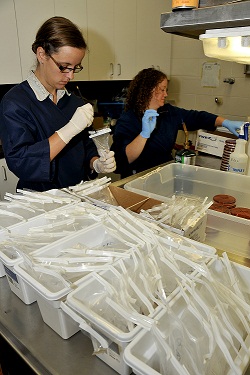Probiotics improve poultry health, performance
Published: July 12, 2013
Source : University of Arkansas, Agricultural Communication Services
FAYETTEVILLE, Ark. – The most dangerous organisms that attack animal health and compromise food safety are microscopic — tiny bacteria with big names like Salmonella typhimurium and Escherichia coli. Scientists at the University of Arkansas System Division of Agriculture have taken the battle to the enemy by enlisting beneficial microorganisms that fight off the pathogens on their own turf.
As early as 1989, poultry scientists Billy Hargis and Guillermo “Memo” Tellez began working with probiotics — microorganisms that are harmless to an animal host and provide some health benefit. Hargis was a professor at Texas A&M University at the time and Tellez was his Ph.D. student.
“While in Texas, we helped develop and commercialized the first FDA-approved probiotic product,” Tellez said. “It was very expensive, difficult to produce and difficult to administer.”

University of Arkansas System Division of Agriculture poultry scientists Guillermo Tellez, foreground, and Billy Hargis conduct research on the use of probiotics and prebiotics to improve the health, performance and food safety of poultry in the John Kirkpatrick Skeeles Poultry Health Laboratory.

University of Arkansas System Division of Agriculture poultry scientists Guillermo Tellez, foreground, and Billy Hargis conduct research on the use of probiotics and prebiotics to improve the health, performance and food safety of poultry in the John Kirkpatrick Skeeles Poultry Health Laboratory.
The product was effective in competitive exclusion, Hargis said. It successfully displaced pathogenic bacteria in the gastrointestinal tracts of poultry.
The product was not cost effective for poultry producers, but it laid the groundwork for probiotic products they would develop at the University of Arkansas, Tellez said.
After graduation, Tellez returned to his native Mexico, where he continued work on probiotics. Hargis came to Arkansas in 2000, about the same time as two other poultry scientists also working on probiotics. Dan Donoghue joined the Division of Agriculture faculty and his wife, Annie Donoghue, joined the USDA/ARS Poultry Production and Product Safety Research Unit, located on the U of A campus. In 2001, Tellez came to Arkansas as a visiting professor, during a sabbatical from his institution, and stayed.
“We didn’t come as a package,” Hargis said, “but we all had an interest in probiotics, specifically, those useful for competitive exclusion.”
Hargis said his focus since coming to Arkansas has been to find a new approach to identifying and producing useful probiotics that are less costly for the poultry industry. “We felt there was a better way to make it more cost effective,” he said.
 They began their collaboration by identifying probiotic organisms that could be used to protect against pathogens or to treat illnesses resulting from pathogens, Hargis said. A key element of this process is identifying probiotics with sufficient stability so that they can be packaged, stored and delivered alive in a cost-effective manner. They have to be alive when given to the animal.
They began their collaboration by identifying probiotic organisms that could be used to protect against pathogens or to treat illnesses resulting from pathogens, Hargis said. A key element of this process is identifying probiotics with sufficient stability so that they can be packaged, stored and delivered alive in a cost-effective manner. They have to be alive when given to the animal.“Candidates for useful probiotics products do at least one or more of the following,” Hargis said. “They alter the gut environment to favor beneficial organisms, produce substances that reduce the growth of or kill pathogens and new data suggests that some probiotics actually activate host animal defense systems.”
In 2003, working with a local poultry company, they began field trials that showed the probiotic they developed not only decreased the presence of Salmonella in the birds, but also greatly increased growth rate and feed conversion, Hargis said. The probiotics, called direct fed microbials (DFMs) when administered in feed, also decreased infections while reducing the number of medications needed and lowered production costs.
“When we began this work in the 1990s,” Hargis said, “the impetus was food safety. The work now embraces animal health and welfare, alternatives to antibiotics and feed efficiency.”
Poultry science researchers Lisa Bielke, left, and Olivia Faulkner prepare cultures to determine whether Salmonellais present in samples from poultry treated with probiotics.
In 2004, a company was formed to produce the product exclusively for one poultry company. Named Sigrah Zellet LLC (Hargis’ and Tellez’s names spelled backwards) the company was intended to pay royalties to the Division of Agriculture and help support ongoing research in probiotics.
In 2008, Pacific Vet Group, a company owned by a consortium of Asian countries and based in Tucson, Ariz., purchased Sigrah Zellet. Hargis said PVG formed a new company, PVG-USA, which is based in Fayetteville. Hargis, Tellez and Chris Pixley, who joined Sigrah Zellet to run the company, remain part owners in the new company.
PVG-USA markets probiotic products primarily in the U.S., but also to poultry companies in a number of Asian and South American countries. In its first year, Hargis said, the company made $250,000. It’s sales have doubled every year since and in 2012 is expected to earn $5 million and employ 28 people.
“It’s the fourth largest biotech company in Arkansas,” Hargis said.
The Division of Agriculture developed and patented four of the five probiotic and prebiotic products the company markets and those account for 95 percent of its profits.
Royalties and research support also come back to the Division of Agriculture, Hargis said, sponsoring continuing research in probiotics and related work in prebiotics.
Prebiotics are nutritive substrates that the host animal can’t use but that support beneficial microorganisms, Hargis said. “Think of prebiotics like fertilizer,” he said
“When you use prebiotics and probiotics together, the product is called synbiotic,” Hargis said. “The concept is like using grass seed mixed with fertilizer.”
There are several such products on the market, but Hargis said the research data supporting them is thin or inconsistent.
Hargis, Tellez and Donoghue are always looking for improved products that will benefit the poultry industry and its consumers.
“We think we’ve done something remarkable,” Hargis said. “It’s really quite impressive. But we still think we can make it better and now, with support from PVG-USA, we have the funding we need to continue the work.”
Source
University of Arkansas, Agricultural Communication ServicesRelated topics:
Mentioned in this news release:
University of Arkansas (USA)
Recommend
Comment
Share

Would you like to discuss another topic? Create a new post to engage with experts in the community.






